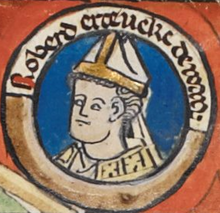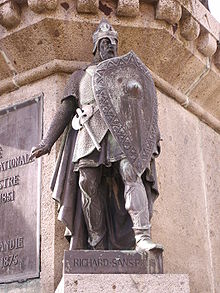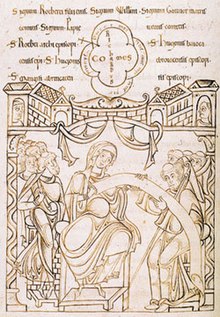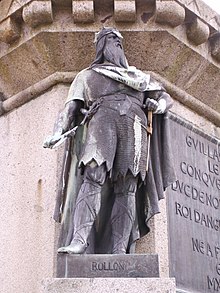Richard was the eldest son of Robert II Archbishop of Rouen and Count of Évreux and Herleva.[1] Richard, son of the Archbishop Robert, donated a mill at Evreux to the abbey of Jumièges by charter dated [26 Mar 1038/14 Apr 1039]. He is mentioned in a charter of King William I confirming Richard as having been a benefactor to that abbey.[2] Richard and his wife, Godechildis, founded Saint-Sauveur d´Evreux.[3] He, as Count of Evreux, donated the church of Gravigny to Sainte-Trinité de Rouen, dated [1052/66]. Richard donated the tithe of a town to the abbey of Saint-Taurin.[4]
Robert II or Robert the Dane, Archbishop of Rouen (bef. 989–1037),[a] and Count of Évreux was a powerful and influential prelate, and a family member of and supporter of five dukes of Normandy.
Robert was a son of Richard I, Duke of Normandy and his second wife, Gunnora.[1

Richard I (28 August 933 – 20 November 996), also known as Richard the Fearless (French, Richard Sans-Peur)(Old Norse,"Jarl Richart) was the Count of Rouen or Jarl of Rouen from 942 to 996.[1] Dudo of Saint-Quentin, whom Richard commissioned to write the "De moribus et actis primorum Normanniae ducum" (Latin, "On the Customs and Deeds of the First Dukes of Normandy"), called him a Dux. However, this use of the word may have been in the context of Richard's renowned leadership in war, and not as a reference to a title of nobility.[2][3] Richard either introduced feudalism into Normandy or he greatly expanded it. By the end of his reign, most important Norman landholders held their lands in feudal tenure.[4]
Richard was born to William Longsword, princeps (chieftain or ruler)[5] of Normandy, and Sprota.[1] His mother was a Breton concubine captured in war and bound to William by a more danico marriage.[6] He was also the grandson of the famous Rollo. William was told of the birth of a son after the battle with Riouf and other Viking rebels, but his existence was kept secret until a few years later when William Longsword first met his son Richard. After kissing the boy and declaring him his heir, William sent Richard to be raised in Bayeux.[7] Richard was about ten years old when his father was killed on 17 December 942.[1] After William was killed, Sprota became the wife of Esperleng, a wealthy miller. Rodulf of Ivry was their son and Richard's half-brother.[8]

Gunnora (or Gunnor) (circa 936 – 5 Jan 1031) was a Duchess of Normandy and the wife of Richard I of Normandy.
The names of Gunnora's parents are unknown, but Robert of Torigni wrote that her father was a forester from the Pays de Caux or possibly of Danish King Harald Bluetooth and according to Dudo of Saint-Quentin she was of noble Danish origin.[2] Gunnora was probably born c. 950.[3] Her family held sway in western Normandy and Gunnora herself was said to be very wealthy.[4] Her marriage to Richard I was of great political importance, both to her husband[b] and her progeny.[5] Her brother, Herfast de Crepon, was progenitor of a great Norman family.[4] Her sisters and nieces[c] married some of the most important nobles in Normandy.[6]

William Longsword (French: Guillaume Longue-Épée, Latin: Willermus Longa Spata, Old Norse: Vilhjálmr Langaspjót), (c. 893 – 17 December 942) was the second ruler of Normandy, from 927 until his assassination in 942.[1]
He is sometimes anachronistically dubbed "Duke of Normandy", even though the title duke (dux) did not come into common usage until the 11th century.[2] Longsword was known at the time by the title Count (Latin comes) of Rouen.[3][4] Flodoard—always detailed about titles—consistently referred to both Rollo and his son William as principes (chieftains) of the Norse.[5]
William Longsword was born "overseas"[a][6] to the Viking Rollo (while he was still a pagan) and his Christian wife Poppa of Bayeux.[7][8] Dudo of Saint-Quentin in his panegyric of the Norman dukes describes Poppa as the daughter of a Count Beranger, the dominant prince of that region.[9] In the 11th century Annales Rouennaises (Annals of Rouen), she is called the daughter of Guy, Count of Senlis,[10] otherwise unknown to history.[b] Despite the uncertainty of her parentage she was undoubtedly a member of the Frankish aristocracy.[11] According to the Longsword's planctus, he was baptized a Christian probably at the same time as his father,[12] which Orderic Vitalis stated was in 912, by Franco, Archbishop of Rouen.[13]

Luitgarde of Vermandois (c. 914 – February 9, 978) was a French noblewoman. She was a countess of Vermandois by birth and a duchess consort of Normandy by her first marriage, and a countess consort of Blois by her second. She was a daughter of Herbert II of Vermandois, and Adele, daughter of Robert I of France.[1] She first married William I of Normandy in 940. This marriage was childless. As a widow, following his death in 942, she married Theobald I of Blois in 943.
Rollo (Norman: Rou; Old Norse: Hrólfr; French: Rollon; c. 846 – c. 930 AD) was a Viking who became the first ruler of Normandy, a region of France. He is sometimes called the 1st Duke of Normandy. Rollo emerged as the outstanding personality among the Norsemen who had secured a permanent foothold on Frankish soil in the valley of the lower Seine. Charles the Simple, the king of West Francia, ceded them lands between the mouth of the Seine and what is now the city of Rouen in exchange for Rollo agreeing to end his brigandage, and provide the Franks with protection against future Viking raids.[1]
Rollo is first recorded as the leader of these Viking settlers in a charter of 918, and he continued to reign over the region of Normandy until at least 928. He was succeeded by his son, William Longsword in the Duchy of Normandy that he had founded. The offspring of Rollo and his followers became known as the Normans. After the Norman conquest of England and their conquest of southern Italy and Sicily over the following two centuries, their descendants came to rule Norman England (the House of Normandy), the Kingdom of Sicily (the Kings of Sicily) as well as the Principality of Antioch from the 10th to 12th century, leaving behind an enduring legacy in the historical developments of Europe and the Near East.[2] The Savoy dynasty family built a castle in Switzerland which was called castrum de Ruello in 1295 AD which is thought to have been named in honor of Rollo.

Poppa of Bayeux was the Christian wife or mistress[1] (perhaps more danico)[2] of the Viking conqueror Rollo. She was the mother of William I Longsword and grandmother of Richard the Fearless, who forged the Duchy of Normandy into a great fief of medieval France.[3] Dudo of Saint-Quentin, in his panegyric of the Norman dukes, describes her as the daughter of a "Count Berengar", the dominant prince of that region, who was captured at Bayeux by Rollo in 885 or 889.[4] This has led to speculation that she was the daughter of Berengar II of Neustria. Despite the uncertainty of her parentage, she undoubtedly was a member of the Frankish aristocracy.[5] A statue of Poppa stands at the Place de Gaulle in Bayeux.

No hay comentarios:
Publicar un comentario